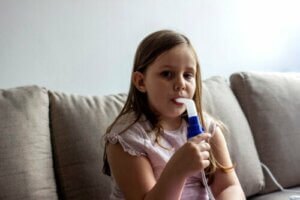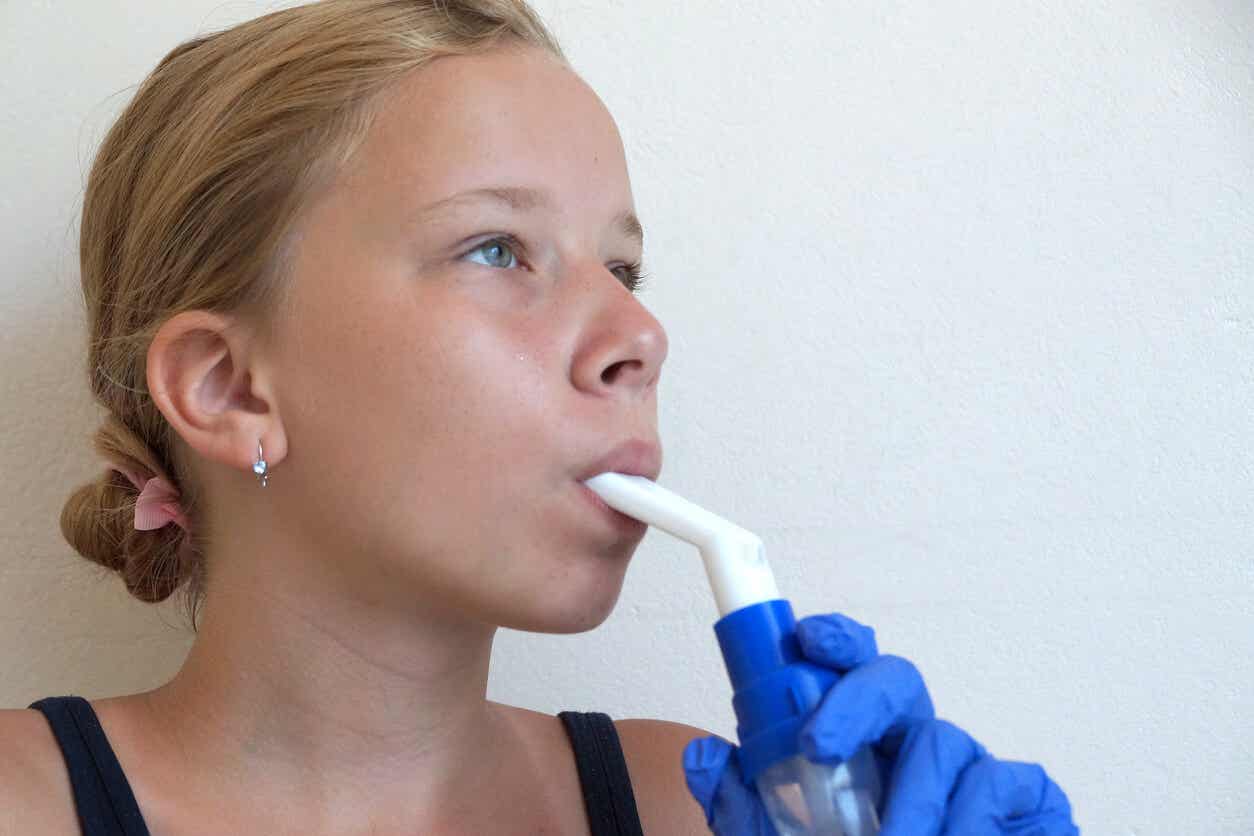Respiratory Physiotherapy in Pediatric Patients


Written and verified by the physiotherapist Maria Elisa Lisotti Luppi
Respiratory physiotherapy is quite beneficial for babies and children. During childhood, the respiratory system is still developing, and respiratory episodes are fairly frequent.
However, certain children may suffer from more serious episodes and develop health problems. In fact, there are many pediatric pulmonary diseases. This is why you shouldn’t underestimate your children’s cough or secretions. Early visits to the doctor and treatments will lead to a better prognosis.
The main goal of respiratory physiotherapy is to help children reduce lung obstructions. Furthermore, it prevents or treats possible complications that may result from respiratory episodes and structural damages from the children’s bodies.
What is respiratory physiotherapy?
Respiratory physiotherapy divides into two different areas: Adult respiratory physiotherapy and pediatric respiratory physiotherapy. In addition, it includes passive therapy (performed by the therapist) and active therapy (performed by the patient without the help of another person). Sometimes, patients need to use some type of element during the session.

This treatment helps eliminate secretions from the respiratory airways and improves the breathing process. What’s more, it treats acute respiratory diseases, as well as chronic respiratory diseases.
When and how is this type of therapy effective for children and babies?
Pediatric physiotherapy includes passive, painless, and very effective techniques. Results are immediate. During the visit to the doctor, parents should be with their children in order to keep them calm.
In addition, parents must learn basic care measures to practice at home. These include nasal irrigation and certain positions that help reduce secretions.
This kind of therapy is used for children who suffer from bronchitis, bronchiolitis, or asthma. Moreover, it’s also very helpful in the case of cystic fibrosis, neuromuscular diseases, or any kind of disease that causes bronchial secretions.
The benefits in children and babies
Pediatric respiratory physiotherapy has many benefits. Among them, it promotes the elimination of secretions in the upper and lower respiratory airways. Furthermore, by reducing secretions, children start eating more.
It’s an effective treatment for bacterial bronchitis
In the case of bacterial bronchitis, respiratory physiotherapy drains abundant secretions, reducing the need for medication. In addition, patients who need to be hospitalized are discharged sooner.
If children stay home, the treatment is carried out at home, too. In some cases, parents learn techniques to treat their children.
The multidisciplinary care of cystic fibrosis
Children who suffer from cystic fibrosis need a multidisciplinary expert team. Respiratory physiotherapy plays an essential role in improving breathing and quality of life. Therefore, it’s very important for children to be evaluated by a physiotherapist as soon as possible, in order to begin treatment immediately.
It reduces pulmonary infections
Children are still developing their respiratory systems. This, added to their genetic influences, may cause them to develop chronic or acute, bacterial or viral pulmonary infections. In addition, they can also be localized or diffused.
Early respiratory physiotherapy works to reduce bronchial obstruction and lung distention. Therefore, it reduces symptoms, like coughing and noises produced by inspiration or expiration.
It fosters a better quality of life when the patient suffers from neurological diseases
In the case of children who suffer from chronic pathologies, like brain damage or chronic diseases, respiratory physiotherapy involves a specialized team. This group of children displays physical, mental, sensory, or intellectual impairments, which affect their everyday lives. In this case, the positive effects of respiratory physiotherapy are quite immediate after each session. Moreover, it offers benefits in the short and long term.

Preventive measures to take into account regarding respiratory physiotherapy
Whenever your children present respiratory symptoms, you should go to the doctor right away. Among these symptoms, you should consider coughing, breathing difficulty, nasal secretions, and noises your children may make when breathing.
There are certain restrictions regarding respiratory physiotherapy in children and babies. It happens in the case of tumors in the respiratory system and if children suffer from certain diseases, like epiglottitis. It also happens in more specific cases, like important circulatory system diseases or after brain surgery. In all of these cases, the pediatrician must approve this kind of therapy.
Therefore, it’s important to pay attention to symptoms, in order to begin pediatric respiratory physiotherapy in time. You shouldn’t think of it as a last resource after using medication.
Respiratory physiotherapy replaces or makes up for possible failures of the respiratory system. Respiratory failure can be temporary or not. Remember that the most frequent types aim to move or eliminate secretions.
Respiratory physiotherapy is quite beneficial for babies and children. During childhood, the respiratory system is still developing, and respiratory episodes are fairly frequent.
However, certain children may suffer from more serious episodes and develop health problems. In fact, there are many pediatric pulmonary diseases. This is why you shouldn’t underestimate your children’s cough or secretions. Early visits to the doctor and treatments will lead to a better prognosis.
The main goal of respiratory physiotherapy is to help children reduce lung obstructions. Furthermore, it prevents or treats possible complications that may result from respiratory episodes and structural damages from the children’s bodies.
What is respiratory physiotherapy?
Respiratory physiotherapy divides into two different areas: Adult respiratory physiotherapy and pediatric respiratory physiotherapy. In addition, it includes passive therapy (performed by the therapist) and active therapy (performed by the patient without the help of another person). Sometimes, patients need to use some type of element during the session.

This treatment helps eliminate secretions from the respiratory airways and improves the breathing process. What’s more, it treats acute respiratory diseases, as well as chronic respiratory diseases.
When and how is this type of therapy effective for children and babies?
Pediatric physiotherapy includes passive, painless, and very effective techniques. Results are immediate. During the visit to the doctor, parents should be with their children in order to keep them calm.
In addition, parents must learn basic care measures to practice at home. These include nasal irrigation and certain positions that help reduce secretions.
This kind of therapy is used for children who suffer from bronchitis, bronchiolitis, or asthma. Moreover, it’s also very helpful in the case of cystic fibrosis, neuromuscular diseases, or any kind of disease that causes bronchial secretions.
The benefits in children and babies
Pediatric respiratory physiotherapy has many benefits. Among them, it promotes the elimination of secretions in the upper and lower respiratory airways. Furthermore, by reducing secretions, children start eating more.
It’s an effective treatment for bacterial bronchitis
In the case of bacterial bronchitis, respiratory physiotherapy drains abundant secretions, reducing the need for medication. In addition, patients who need to be hospitalized are discharged sooner.
If children stay home, the treatment is carried out at home, too. In some cases, parents learn techniques to treat their children.
The multidisciplinary care of cystic fibrosis
Children who suffer from cystic fibrosis need a multidisciplinary expert team. Respiratory physiotherapy plays an essential role in improving breathing and quality of life. Therefore, it’s very important for children to be evaluated by a physiotherapist as soon as possible, in order to begin treatment immediately.
It reduces pulmonary infections
Children are still developing their respiratory systems. This, added to their genetic influences, may cause them to develop chronic or acute, bacterial or viral pulmonary infections. In addition, they can also be localized or diffused.
Early respiratory physiotherapy works to reduce bronchial obstruction and lung distention. Therefore, it reduces symptoms, like coughing and noises produced by inspiration or expiration.
It fosters a better quality of life when the patient suffers from neurological diseases
In the case of children who suffer from chronic pathologies, like brain damage or chronic diseases, respiratory physiotherapy involves a specialized team. This group of children displays physical, mental, sensory, or intellectual impairments, which affect their everyday lives. In this case, the positive effects of respiratory physiotherapy are quite immediate after each session. Moreover, it offers benefits in the short and long term.

Preventive measures to take into account regarding respiratory physiotherapy
Whenever your children present respiratory symptoms, you should go to the doctor right away. Among these symptoms, you should consider coughing, breathing difficulty, nasal secretions, and noises your children may make when breathing.
There are certain restrictions regarding respiratory physiotherapy in children and babies. It happens in the case of tumors in the respiratory system and if children suffer from certain diseases, like epiglottitis. It also happens in more specific cases, like important circulatory system diseases or after brain surgery. In all of these cases, the pediatrician must approve this kind of therapy.
Therefore, it’s important to pay attention to symptoms, in order to begin pediatric respiratory physiotherapy in time. You shouldn’t think of it as a last resource after using medication.
Respiratory physiotherapy replaces or makes up for possible failures of the respiratory system. Respiratory failure can be temporary or not. Remember that the most frequent types aim to move or eliminate secretions.
All cited sources were thoroughly reviewed by our team to ensure their quality, reliability, currency, and validity. The bibliography of this article was considered reliable and of academic or scientific accuracy.
- Pírez, Catalina, et al. “Fisioterapia respiratoria en el tratamiento de niños con infecciones respiratorias agudas bajas.” Archivos de Pediatría del Uruguay 91 (2020): 38-39. http://www.scielo.edu.uy/scielo.php?pid=S1688-12492020000700038&script=sci_arttext
- Bermejo, Mª Inmaculada Moreno. TESIS DOCTORAL Fisioterapia respiratoria combinada con higiene postural en niños con afectación neurológica crónica. Diss. Universidad Complutense de Madrid, 2017. https://core.ac.uk/download/pdf/154286788.pdf
- Conesa Segura, Enrique. “Evaluación clínica de la respuesta a la fisioterapia respiratoria en los niños con diagnóstico de bronquiolitis aguda.” (2019). http://repositorio.ucam.edu/handle/10952/4136
- Le Bras, Lucie Rosanna. “Adherencia a la fisioterapia respiratoria con juegos lúdicos en niños con fibrosis quística: estudio transversal.” (2019). https://repositorio.usj.es/handle/123456789/210
- Rezabala Farfan, Alan José, and Jamil Antonio Tocto Tapia. Eficacia de la fisioterapia respiratoria en la bronquitis en niños del área de pediatría del Hospital General Rodríguez Zambrano, Manta–Manabí, periodo octubre 2019–marzo 2020. BS thesis. Babahoyo: UTB-FCS, 2020, 2020. http://dspace.utb.edu.ec/handle/49000/8116
- Álvarez Santillán, Julaisa De Los Ángeles, and Daniel Humberto Ordoñez Bajaña. Técnicas de fisioterapia respiratoria y su influencia en la calidad de vida de los niños con asma de 2 a 5 años en la ciudadela la ventura en el periodo mayo–septiembre del 2019. BS thesis. Babahoyo: UTB-FCS, 2019, 2019. http://dspace.utb.edu.ec/handle/49000/6958
This text is provided for informational purposes only and does not replace consultation with a professional. If in doubt, consult your specialist.








